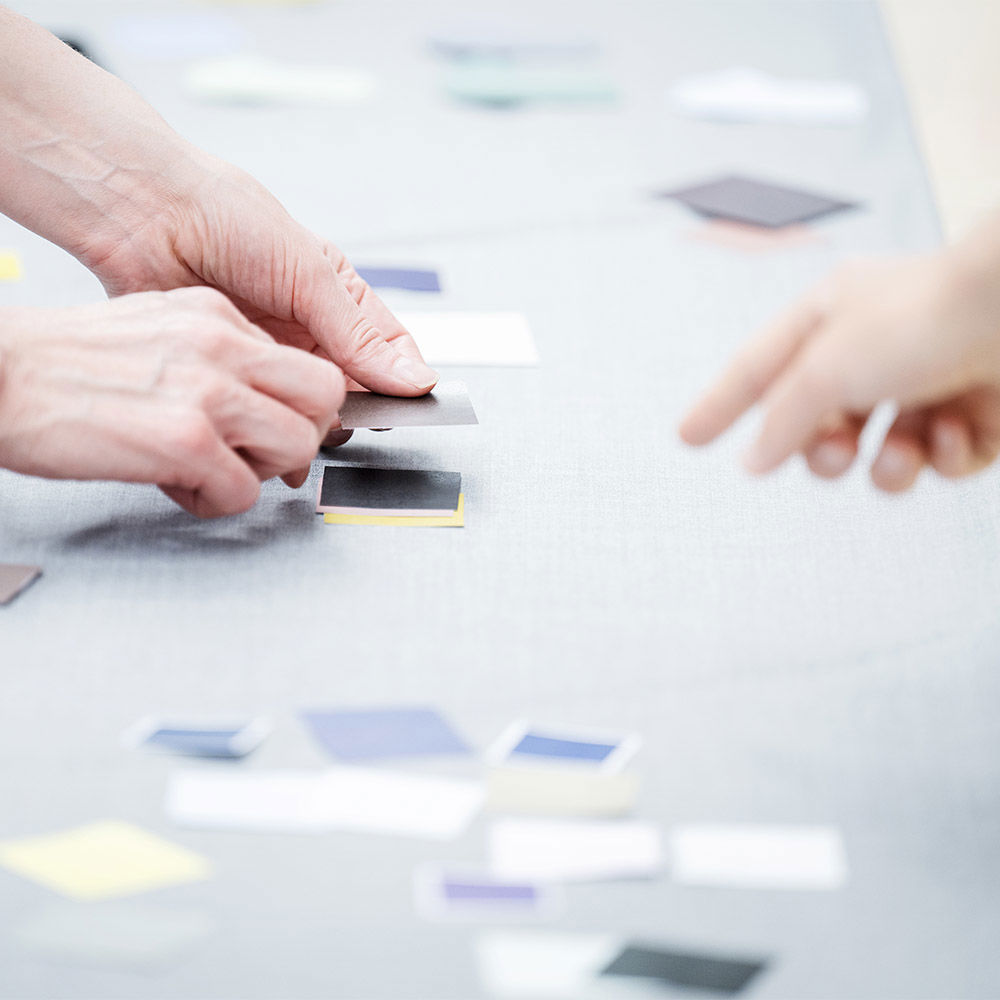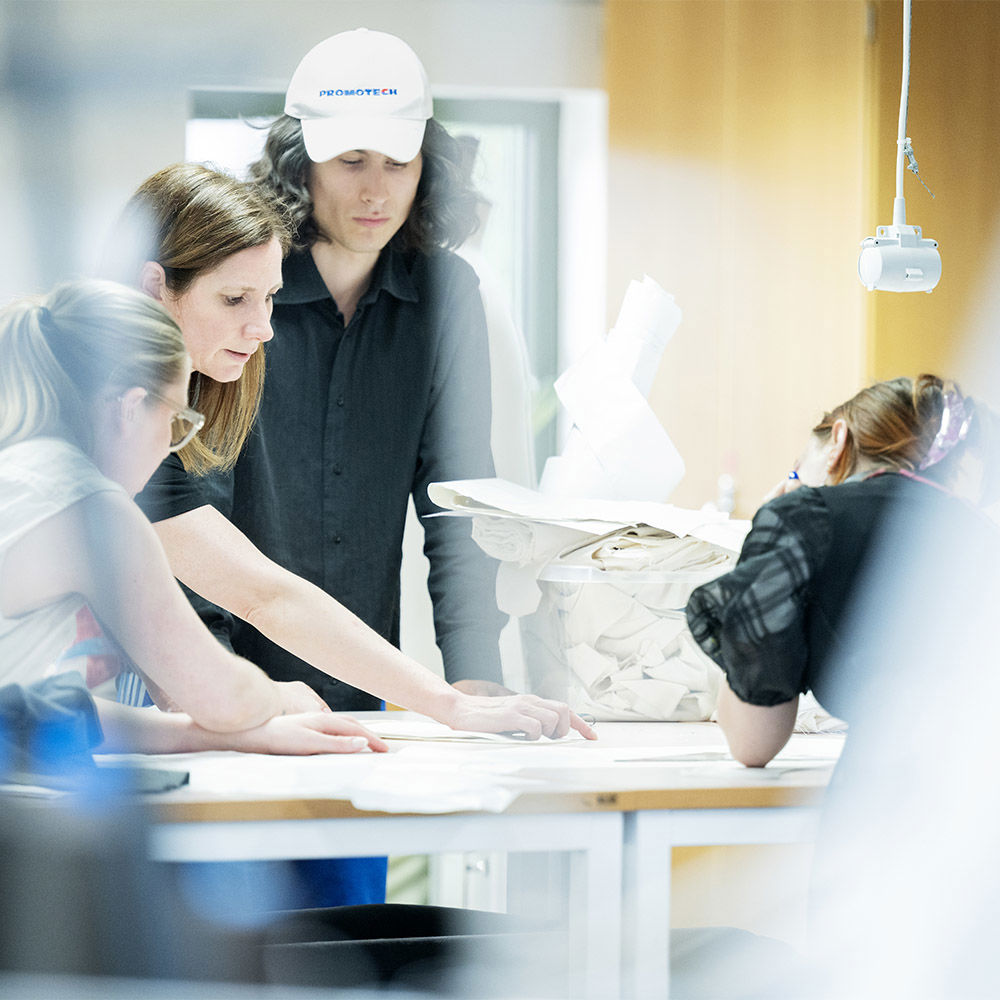The new UN tour guide collection – from idea to design
The finished collection was launched with a spectacular fashion show at the United Nations on 22 April 2025. Since then, the collection has been the guides’ workwear.
But on this morning in Backåkra, the final results were still very distant. Twenty Bachelor’s and Master’s of Fine Arts students in Fashion and Textile Design, together with their design leaders, stepped out of the bus lugging sleeping bags and suitcases. They also carried their first sketches of how they envisioned a collection inspired by the UN's guiding principles: peace, dignity, and equality on a healthy planet.
“On our visit, we took in these very special surroundings. We visited the beach early in the morning, we felt the peace at the meditation circle in the meadow with the big peace stone, and we collected ideas for colours, textures, and design expressions,” said Karin Landahl, Senior Lecturer in Design at the Swedish School of Textiles and a artistic director for the project.
Inclusion and diversity
This was the start of an intensive effort to develop a collection that combines sustainability, inclusion, innovation and creativity with comfort and functionality for the tour guides who now wear these garments every day when they represent the UN to some 200,000 visitors annually – from world leaders to school classes.
Jonas Gustavsson, a student in the project, noted that from the start when they started brainstorming in Backåkra, the design team agreed that the new collection should be based on inclusion and diversity.
“We also looked at references of different types of traditional clothing to explore how they could be thoughtfully incorporated into the collection. We also wanted to include the spirit of Dag Hammarskjöld and his vision of a united world,” he said.
A collaborative approach
In early spring 2024, a close collaboration with the UN and, in particular, the UN tour guides began.
“In the design process, we have used a collaborative working method. Innovation thrives on collaboration and the creative process has been a dialogue between cultures, experiences, and different backgrounds. Ideas and perspectives have been exchanged and embraced. There is not one person who can say ‘I designed that detail;’ rather, the whole collection was designed by the whole team,” said Stefanie Malmgren de Oliveira, Senior Lecturer at the Swedish School of Textiles and also an artistic director.
Andrea Rehbein, a student in the project, said that the approach has been challenging. “It has been about compromise and dialogue, bringing together many views and distilling their essence. We tried to break the hierarchy of the design process but at the same time we needed to meet the needs of a hierarchical organisation like the UN. It meant a back and forth of creating, reflecting on feedback, and continuing to work. In the end, everything we have done has had a purpose,” she said.
The overall leadership and management of the project has been provided by the Swedish School of Textiles and the work has involved a large project group, which includes the design team. The design work was carried out through an independent course, which could be applied for by all design students at the Swedish School of Textiles. Everyone who applied was accepted and the group eventually consisted of students from all years of the Bachelor’s and Master’s of Fine Arts programmes in Fashion and Textile Design. The students then worked on the UN project alongside their regular full-time studies.
Playing with lines – interplay between architecture and nature
When design leaders Stefanie Malmgren de Oliveira and Karin Landahl visited the UN headquarters for the first time in spring 2024, they discovered an exciting relationship between the natural surroundings in Backåkra and the architecture of the headquarters.
“The headquarters are an architectural masterpiece with a combination of very clean lines on the outside and undulating lines and stunning art on the inside. The headquarters are also characterised in many parts by a stripped-down aesthetic,” explained Stefanie Malmgren de Oliveira.
Juliët Zuurman, a student, said that in the design process, they found a way to merge inspiration from Backåkra with inspiration from the UN headquarters in New York City into one narrative. “The connection between these two places has been very important to us; it's where we found the colours of the collection, for example. Based on this narrative, we have worked with an interplay of asymmetric lines. We see the asymmetry as a symbol of dialogue,” she said.
Unique collaboration with the UN
In spring 2024, the design team produced prototypes that were tested by the tour guides in New York City. Adjustments were then made to meet the practical needs of the guides while preserving the design expression.
As Paweł Robuta, student, explained, “The experience of working with an organisation like the UN is very unique, especially for those of us who are students. We learned to communicate, not only within our own group, but also to take our decisions further and present them to the people at the UN.”
In the autumn and winter of 2024, the finished products then went into production.
“We are very proud of the finished collection. It expresses the UN's values and our design idea while also meeting the guides’ needs. In addition, the collection contains several sustainable solutions on social, economic, and ecological levels, which can inspire others to create sustainable fashion,” said Karin Landahl.


